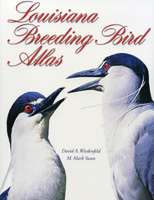LOUISIANA BREEDING BIRD ATLAS
 | Featured among Notable Government Documents of 2000 presented in Government Information at a Crossroads by Margaret M. Jobe, Library Journal May 15, 2001, New York, pp. 62-66. |
Internet version: Wiedenfeld, David A., and M. Mark Swan. 2000. Louisiana Breeding Bird Atlas. Published by Louisiana Sea Grant College Program, Louisiana State University, Baton Rouge. 78 pp.
The maps show sample locations of 161 species of birds. On the maps, each dot, rectangle, square, or empty space represents a 7.5-minute quadrangle (approximately 7 x 7 miles) and indicates the highest level of breeding evidence reported during 1994, 1995, and 1996. A dot indicates that evidence of "possible" breeding was found during the Atlas period. A small rectangle denotes "probable" breeding, and a square denotes "confirmed" breeding (e.g, fledglings or nests were observed). Blocks lacking any evidence of breeding could be due to absence of the species, absence of observers, or other factors. Evidence found during the Atlas period does not affirm that nesting has occurred since then. The Atlas is meant to show a "snapshot" of species distributions during the years 1994-1996. An appropriate use of the Atlas maps would be in understanding the general range of a species, to be refined with more precise information about the extent of the habitat of each species.
The Louisiana Breeding Bird Atlas was funded by the National Fish and Wildlife Foundation, USGS Gap Analysis Program, Barataria-Terrebonne National Estuary Program, U.S. Fish & Wildlife Service, and National Resources Conservation Service. Canon U.S.A., Inc. and the Louisiana Sea Grant Program provided funds to publish the Atlas. David Wiedenfeld coordinated the Atlas program from an office at the Louisiana Natural Heritage Program of the Louisiana Department of Wildlife & Fisheries. Acknowledgements for pictures and photographs accompany the maps, linked below. Methodology and vital acknowledgements will be posted here soon. 186 observers participated in bird surveys for the Atlas.
Copies of the Louisiana Breeding Bird Atlas are available by mail from Louisiana Sea Grant and The Nature Conservancy (see below). Contact Louisiana Sea Grant Communications Office, 101 Sea Grant Building, Louisiana State University, Baton Rouge, LA 70803. Phone: (225) 578-6564 or (225) 578-6448. Contact Elizabeth Coleman for more information about Sea Grant's communications products.
Copies of the Louisiana Breeding Bird Atlas are also available by mail by sending a check made out to "The Nature Conservancy" with "Midwest Mapping" in the memo line for $20 (which covers postage and packaging) to:
Malcolm Swan, GIS Analyst
Midwest U.S. Conservation Region
The Nature Conservancy
711 Navarro, Suite 410
San Antonio TX 78209
(210) 224-8774 ext. 234
The Nature Conservancy
Pied-billed Grebe, Brown Pelican, Anhinga
Cormorants: Neotropic Cormorant and Double-crested
Least Bittern and Night-Herons: Black-crowned and Yellow-crowned
Herons: Green, Tricolored, and Little Blue Heron
Egrets: Reddish, Snowy, and Cattle
Great Egret, Great Blue Heron, and Glossy Ibis
Ibis: White-faced and White
Roseate Spoonbill and Whistling-Ducks: Fulvous and Black-bellied
Canada Goose, Mallard, and Mottled Duck
Blue-winged Teal, Wood Duck, and Hooded Merganser
Rails: King and Clapper
Common Moorhen, American Coot, and American Oystercatcher
Black-necked Stilt and Plovers: Snowy and Wilson's
Killdeer, Willet, and American Woodcock
Laughing Gull and Terns: Forster's and Gull-billed
Terns: Least, Sandwich, and Royal
Terns: Caspian and Sooty; and Black Skimmer
Vultures: Turkey and Black; and Bald Eagle
Kites: Mississippi, White-tailed, and Swallow-tailed
Hawks: Sharp-shinned, Cooper's, and Red-shouldered
Hawks: Broad-winged and Red-tailed; and Osprey
American Kestrel, Northern Bobwhite, and Wild Turkey
Rock Pigeon and Doves: Mourning and White-winged
Common Ground-Dove, Inca Dove, and Eurasian Collared-Dove
Monk Parakeet, Yellow-billed Cuckoo, and Greater Roadrunner
Owls: Barn, Great Horned, and Barred
Eastern Screech-Owl, Chuck-will's-widow, and Common Nighthawk
Chimney Swift, Ruby-throated Hummingbird, and Belted Kingfisher
Northern Flicker and (other) Woodpeckers: Red-bellied and Red-headed
Woodpeckers: Downy, Hairy, and Red-cockaded
Pileated Woodpecker, Eastern Kingbird, and Scissor-tailed Flycatcher
Great Crested Flycatcher, Eastern Wood-Pewee, and Eastern Phoebe
Acadian Flycatcher, Horned Lark, and Purple Martin
Swallows: Northern Rough-winged, Cliff, and Barn
Blue Jay and Crows: American and Fish
Tufted Titmouse, Carolina Chickadee, and White-breasted Nuthatch
Brown-headed Nuthatch and Wrens: Carolina and Marsh
Blue-gray Gnatcatcher, Eastern Bluebird, and Wood Thrush
American Robin, Loggerhead Shrike, and Gray Catbird
Northern Mockingbird, Brown Thrasher, and European Starling
Vireos: White-eyed, Yellow-throated, and Red-eyed
Vireos: Warbling and Bell's; and Prothonotary Warbler
Northern Parula and (other) Warblers: Black-and-white and Yellow-throated
Warblers: Prairie, Pine, and Kentucky
Warblers: Hooded, Worm-eating, and Swainson's
Louisiana Waterthrush, Common Yellowthroat, and Yellow-breasted Chat
American Redstart, Northern Cardinal, and Blue Grosbeak
Buntings: Indigo and Painted; and Dickcissel
Sparrows: Seaside, Lark, and Bachman's
Sparrows: Field and Chipping; and Eastern Towhee
Eastern Meadowlark, Red-winged Blackbird, and Brown-headed Cowbird
Bronzed Cowbird and Grackles: Common and Boat-tailed
Great-tailed Grackle and Orioles: Orchard and Baltimore
Tanagers: Summer and Scarlet; and House Sparrow
House Finch